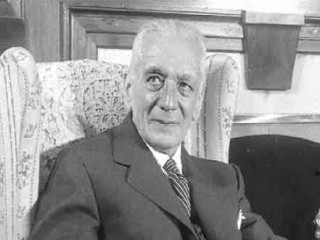
Laureano Gomez biography
Date of birth : 1889-02-20
Date of death : 1965-07-13
Birthplace : Bogota,Columbia
Nationality : Columbian
Category : Politics
Last modified : 2011-10-13
Credited as : Colombian Conservative party, La Unidad, president of Columbia
Laureano Eleuterio Gomez Castro (1889-1965) was leader of the Colombian Conservative party and spokesman of its right wing. He was the fiercest partisan in recent Colombian history and symbolized clerical and authoritarian values.
Born in Bogota on Feb. 20, 1889, Laureano Gomez attended the National University and received an engineering degree in 1909. Turning immediately to a public career, he founded the periodical La Unidad and served as its director from 1909 to 1916. Joining the Conservative party, he was first elected a national representative in 1911, serving until 1918 and again from 1921 to 1923. Subsequently a cabinet minister on various occasions in the 1920s and 1930s, Gomez assumed the leadership of the Conservative party in 1932 and remained its dominant figure until his death. Running the party with iron discipline and intellectual force, he became an admirer of Hitler and of Franco, criticized the United States relentlessly, and attacked a series of Liberal governments while also directing the daily El Siglo, which he founded in 1936.
As a spokesman of the ultraright wing of his party, Gomez personified the Spanish tradition of authoritarian government and clericalism. Representing the feudalistic
and aristocratic landed gentry of Colombia, he became a brilliant parliamentarian and political tactician. His polemical attacks on the Liberals were extreme in their vehemence and contributed to a deterioration of political consensus within the ruling elite. When the Liberals divided over the presidential candidacy of Jorge Gaitin in 1946, Gomez shrewdly manipulated the election of a minority Conservative president. In 1950 he successfully campaigned for the presidency when the Liberals refused to participate.
As president, Gomez proceeded to institute an authoritarian right-wing regime which resembled European corporativist governments. Although stricken by a heart attack in 1951, he continued to control the government through a handpicked successor. The increasing breakdown of public order and the apparent establishment of civilian dictatorship precipitated a military seizure of power in 1953, and Gomez went into exile in Spain. In July 1956 he negotiated with Liberal leader Alberto Lleras Camargo the Pact of Benidorm, which called for bipartisan collaboration in opposition to the military dictatorship. On July 20, 1957, following the collapse of the regime, he and Lleras also signed the Declaration of Sitges, which committed the two parties to an equal division of authority from 1958 until 1974. They agreed to divide political posts equally, the 4-year presidential terms alternating between the two parties.
Although ill health and advanced age prohibited his return to the presidency, Gomez continued to dominate the Conservative party until his death on July 13, 1965, in Bogota.
There is no full-length biography of Gomez. The best review of his personality and political career is in Vernon L. Fluharty, Dance of the Millions: Military Rule and the Social Revolution in Colombia, 1930-1956 (1957). An account which includes the final years of Gomez's career is Robert H. Dix, Colombia: The Political Dimensions of Change (1967). □
















